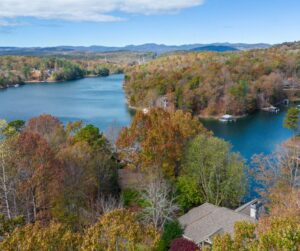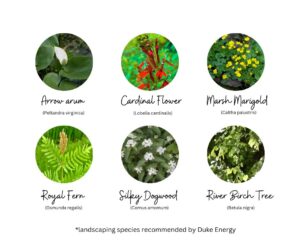As a real estate brokerage with agents who live and work on Lake Keowee, we know first hand that there’s nothing quite like owning a lake home. The fresh air, the sparkling emerald water, and the ability to swim or boat and create memories are all major attractions. However, there are also responsibilities that come with lake living – namely, keeping your shoreline environmentally friendly. But what’s the best way to protect your property? Read on to find out how to keep your piece of paradise in tip-top shape.
The stretch of land along the water’s edge: the riparian zone.
The riparian zone is a haven for biodiversity, providing a valuable habitat for birds, fish and other aquatic animals. Not only does it provide safe refuge for all sorts of critters, but it also ensures that our water is CLEAN – the riparian zone filters and reduces run-off from sediment and pollutants like oil and fertilizer. It plays a huge role in keeping erosion and poor water quality at bay.
Safeguarding your riparian zone means far more than just hunting down debris, the odd escaped noodle, or wayward lake toy. The most effective way to protect these areas from degradation is through “shoreline stabilization”, practices that involve either structural or vegetative systems, or a combination of both, to reduce water impact and increase resilience against erosion. What makes this approach so appealing is that the most natural, cost-effective solutions are often also aesthetically pleasing and eco-friendly, making it an optimal choice for Lake Keowee.
Forget pricey options – why not turn to Mother Nature?
Using vegetation may be the best (not to mention least expensive!) way to stabilize shoreline. While it’s true that certain criteria must be met for this method, such as existing similar plants and shorelines with soil types suitable for plant growth, it can be an incredibly powerful tool. With woody vegetation at the water line and perennial grasses providing an expansive root system along the banks, healthy emergent aquatic plants can form a protective barrier against potentially damaging wave activity. Bringing in more flood-tolerant shrubs and trees inland can give your shoreline comprehensive stability. It’s nature’s own remedy.

Hard Stabilization Structures: designed with fortitude in mind.
Hard stabilization structures are used to increase shoreline and bank resistance to erosive forces such as waves or wind. These structures do not actually decrease the energy of water, but rather divert it away from the shoreline. They are ideally situated in locations with excessive wave action, from boat traffic or zooming jet-skis, where the soil or lack of sunlight is not suitable for plant growth, or when a bank cannot be re-graded to have a 2:1 slope.
- Bulkheads & Seawalls – Engineered structures such as vertical timbers, sheet piling or concrete which are built parallel to the shoreline.
- Revetments or riprap – Made of rocks, relatively easy to install or repair, and provides a better aquatic habitat than seawalls.
- Enhanced riprap – Enhanced riprap takes protection to the next level. With stones sized precisely according to the environmental conditions, enhanced riprap can be custom fit so that no exposed soil remains. And with all those little crevices between rocks, this upgraded riprap lets nature do its work, allowing vegetation taking root in the sheltered gaps.
Shoreline stabilization isn’t just a suggestion – it’s essential!
If you’re located in the back of a cove, or if your shoreline is low-lying and isn’t eroding, you may be off the hook. However if this isn’t your situation, it may require stabilizing. Here are a few steps to get started:
- Evaluate Your Shoreline: Is your shoreline looking slightly eroded? Check its health with these five diagnostic characteristics: what’s the existing vegetation like, how does it respond to changing water levels, is wave energy from boat traffic and wind taking its toll, have you felt any sloping issues on land or in the waters below? Finally, what is your soil type?
- Call Duke Energy’s Lake Services: Their staff can help you figure out which permit to apply for and any additional restrictions or requirements. Reach them at 1-800-443-5193.
- Talk to an expert: Hire an experienced contractor and explore the possibilities of environmentally-friendly solutions that can leave you with strikingly beautiful results.

Recent Comments